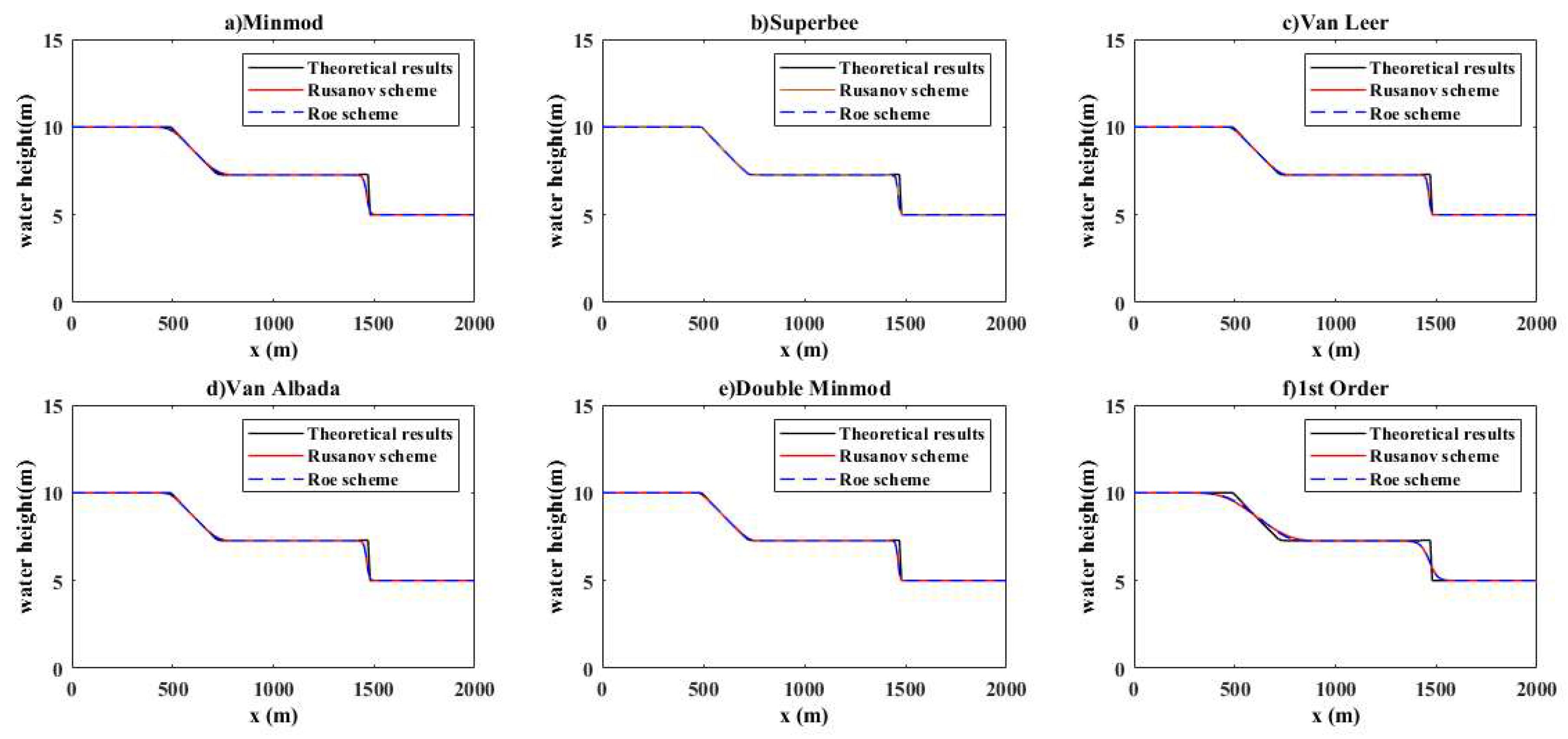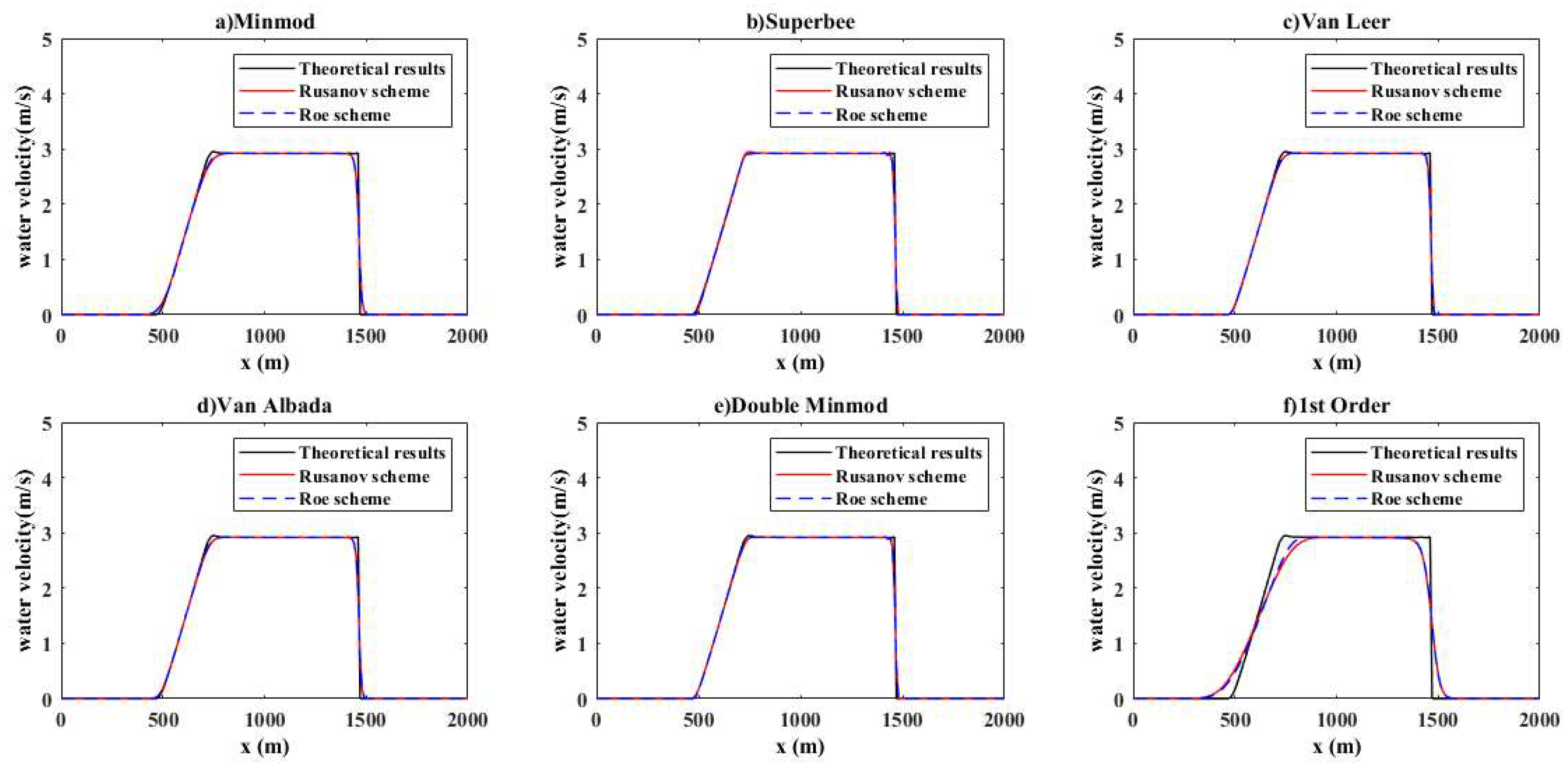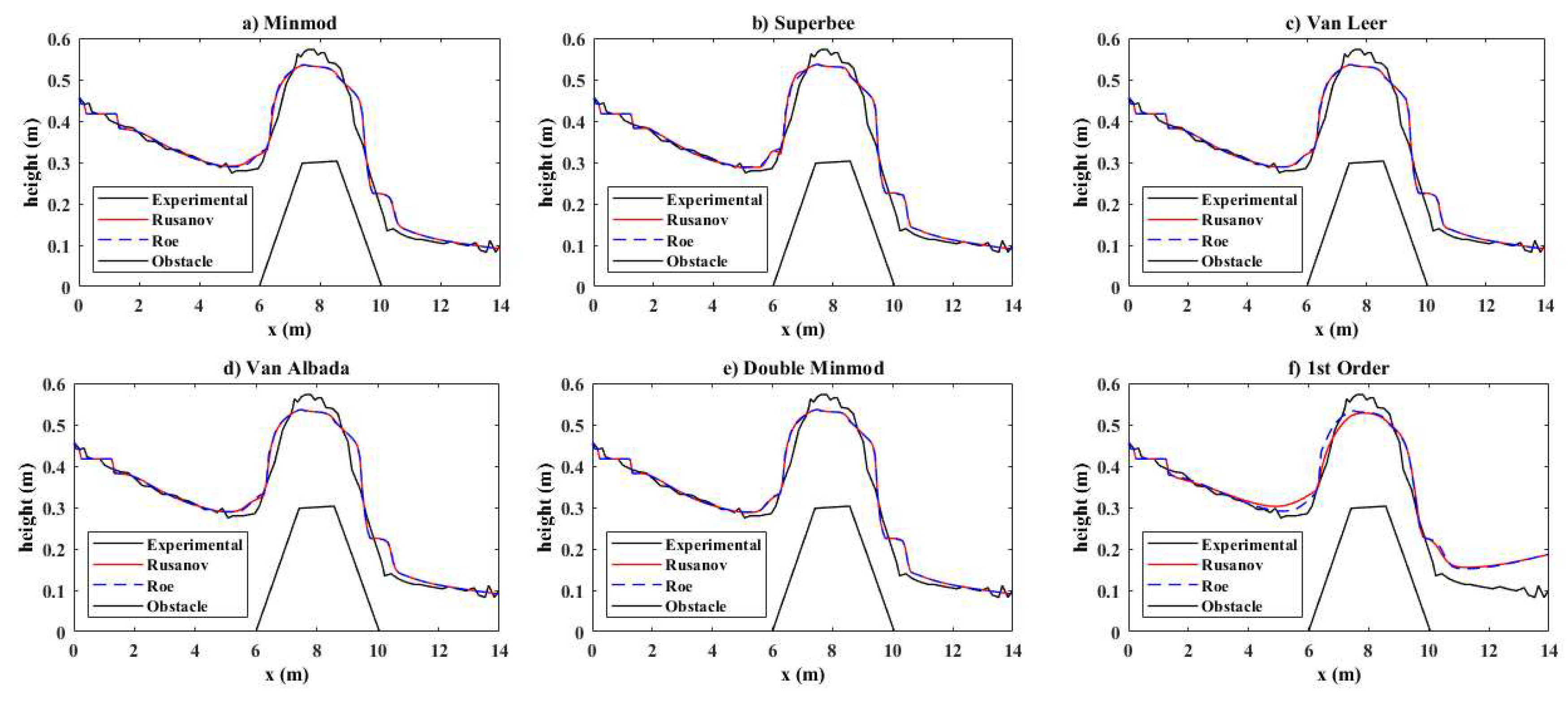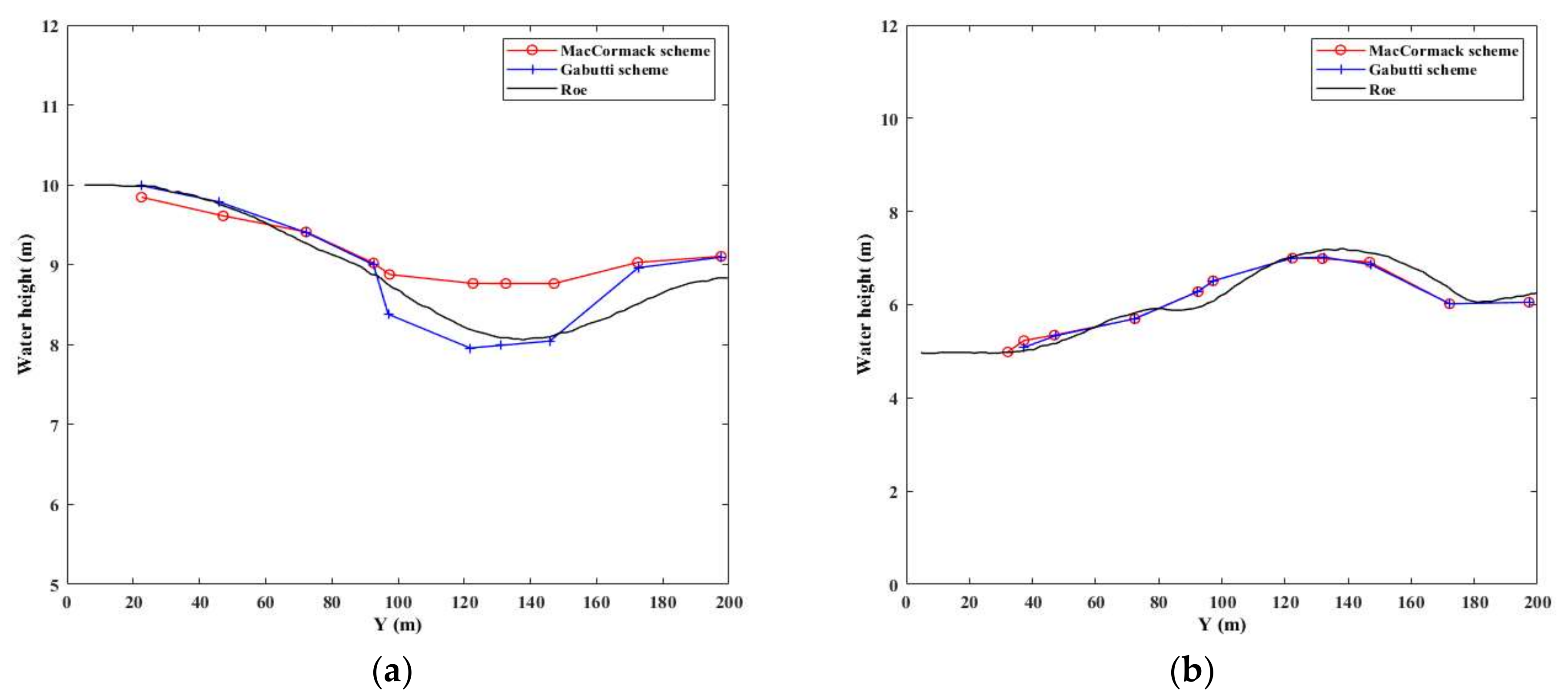A Comprehensive Numerical Overview of the Performance of Godunov Solutions Using Roe and Rusanov Schemes Applied to Dam-Break Flow
Abstract
1. Introduction and Background
2. Description of the Numerical Model
3. Numerical Resolution of the Shallow-Water Equation
3.1. Discretization of the Shallow-Water Equation
- ➢
- In the x-direction
- ➢
- In the y-direction
3.2. The Riemann Problem
- (1)
- The MUSCL-Hancock Scheme
- (2)
- Data Reconstruction
- (3)
- Time Evolution
3.2.1. Rusanov Scheme
3.2.2. Slope Limiter
- (1)
- Van Albada
- (2)
- Van Leer
- (3)
- Double Minmod
- (4)
- Minmod
- (5)
- Superbee
3.2.3. Courant Number
4. Results and Discussion
4.1. 1D Dam-Break Simulation
4.1.1. Computation of the Water Depth: Test 1
4.1.2. Computation of the Water Depth and Velocity: Test 2
- (1)
- Water depth
- (2)
- Water velocity
4.1.3. Dam Break over a Trapezoid Obstacle: Test 3
4.2. 2D Dam-Break Simulation
4.2.1. Description of the Study Case
4.2.2. Initial and Boundaries Conditions
- ➢
- The reflective boundary condition is applied at i + 1/2 of the cell and the equations are given using
- ➢
- In the liberty boundary condition, the borders do not enforce any coercion. That means
- ➢
- In the periodicity boundary condition, the left and right borders are connected.
- ✓
- First-Order partial Dam Break
4.3. Transverse and Longitudinal Profiles
- ✓
- Second-Order partial Dam Break
5. Conclusions
- (1)
- It is established that the proposed second-order approaches with Rusanov and Roe schemes accurately reproduce the theoretical results better than the first-order model. However, the Roe scheme with Van Leer schemes is slightly more accurate when predicting flow events in various combinations of the two schemes and five slope limiters. The Roe scheme with Van Leer is robust and is recommended for further investigations of the dam-break flow.
- (2)
- It confirmed that as the channel length and the ratio of downstream water height increase Van Leer, Minmod, and Van Albada do not distort the results; however, in the case of Superbee and double Minmod some non-physical oscillations are observed at the second inflection point.
- (3)
- When the channel is relatively long, the proposed second-order Godunov–finite volume method with Roe and Rusanov schemes accurately reproduce the water height and velocity for a dam-break flow for both dry and wet bed cases. When using the first-order Godunov–finite volume method, the Roe scheme appears to be more accurate and thus seems ideal for predicting the dam-break flow, and by extension many other less-demanding flows that are highly significance.
- (4)
- Two models only weakly reproduce the theoretical results when using the second-order schemes with Minmod, Superbee, Van Leer, Van Albada, and double Minmod. This is true both at the level of the first point of contact between the obstacle and the failure wave but also at the top of the obstacle. Not surprisingly, the results in the second order are better than those of the first-order schemes. The Roe scheme appears to be slightly more numerically efficient than the Rusanov scheme.
- (5)
- The case of the 2D dam-break simulation reveals a greater approximation with the results obtained using the Gabutti scheme than with those of MacCormack. This reflects the capacity of the model to track the shock wave resulting from the sudden dam rupture.
- (6)
- The second-order precision of the 2D partial dam-break problem with Minmod, Superbee, and Van Leer as slope limiters reveals that the Minmod, Van Leer, and Van Albada slope limiters can be more strongly recommended for further investigations than the Superbee approach.
Author Contributions
Funding
Data Availability Statement
Conflicts of Interest
Notation
| F, G | Flux vectors in the x and y directions; |
| g | Gravitational acceleration; |
| h | Water height; |
| Water height at the left; | |
| Water height at the right; | |
| Wave height at the “star” side; | |
| i, j | Subscript in the x and y direction; |
| L, R | The left and right side of the cell; |
| n | Time level; |
| nm | Manning coefficient; |
| R(r) | Slope limiter; |
| Sfx, Sfy | Manning equation in the x and y directions; |
| Sox, Soy | Source term in the x and y directions; |
| Wave speed at the left side; | |
| Wave speed at the right side; | |
| t | Time; |
| u, v | Velocities in x and y directions; |
| Velocities at the left of x direction; | |
| Velocities at the right of x direction; | |
| U | Conservative variables; |
| Constant states at the left side of Riemann; | |
| Constant states at the right side of Riemann; | |
| Wave speed at the “star” side; | |
| Velocities at the left of y direction; | |
| Velocities at the right of y direction; | |
| x, y | Cartesian Coordinates; |
| Time-step; | |
| Width of the cells i; | |
| Width of the cells j. |
Abbreviations
| Cfs | Cubic foot per second; |
| HLL | Harten-Lax-Leer; |
| HLLC | Harten-Lax-Van Leer-Contact; |
| Ft | Feet; |
| FVM | Finite volume method; |
| NEMA | National Emergency Management Agency; |
| Min | Minutes; |
| MUSCL | Monotone Upstream-centered Scheme for Conservation Laws; |
| SWEs | Shallow-water equations; |
| TVD | Total variation diminishing. |
References
- Wilby, R.L.; Keenan, R. Adapting to flood risk under climate change. Prog. Phys. Geogr. 2012, 36, 348–378. [Google Scholar] [CrossRef]
- Gao, J.; Ji, C.; Liu, Y.; Gaidai, O.; Ma, X.; Liu, Z. Numerical study on transient harbor oscillations induced by solitary waves. Ocean Eng. 2016, 126, 467–480. [Google Scholar] [CrossRef]
- Gao, J.; Ma, X.; Chen, H.; Zang, J.; Dong, G. On hydrodynamic characteristics of transient harbor resonance excited by double solitary waves. Ocean. Eng. 2021, 219, 108345. [Google Scholar] [CrossRef]
- Yanmaz, A.M.; Beser, M.R. On the Reliability-Based Safety Analysis of the Porsuk Dam. Turkish. J. Eng. Environ. Sci. 2005, 29, 309–320. [Google Scholar]
- Singh, V. Dam Breach Modelling. In Technology; Springer: Dordrecht, The Netherlands, 1996; Volume 17. [Google Scholar]
- Feng, Z.Y. The seismic signatures of the surge wave from the 2009 Xiaolin landslide-dam breach in Taiwan. Hydrol. Process 2012, 26, 1342–1351. [Google Scholar] [CrossRef]
- Zoppou, C.; Roberts, S. Numerical solution of the two-dimensional unsteady dam break. Appl. Math. Model. 2000, 24, 457–475. [Google Scholar] [CrossRef]
- Cornwall, W. Catastrophic failures raise alarm about dams containing muddy mine wastes. Science 2020, 20. [Google Scholar] [CrossRef]
- American Society of Civil Engineers. Report of the Committee on the Cause of the Failure of the South Fork Dam. Trans. Am. Soc. Civ. Eng. 1890, 24, 448–451. [Google Scholar]
- Pohle, F.V. The Lagragian Equations of Hydrodynamics: Solutions Which Are Analytic Functions of Time. Ph.D. Thesis, New York University, New York, NY, USA, 1950. [Google Scholar]
- Saint-Venant, A.B. Théorie et equations générales du movement nonpermanent des eaux courantes. Comptes Rendus Séances l’Académie Sci. Paris Fr. Séance 1871, 17, 147–154. [Google Scholar]
- Cunge, J. Practical Aspects of Computational River Hydraulics; Pitman Publishing Ltd.: London, UK, 1980; Volume 420. [Google Scholar]
- Yang, J.; Hsu, C.; Chang, S. Computations of free surface flows Part 1: One-dimensional dam-break flow. J. Hydraul. Res. 1993, 31, 19–34. [Google Scholar] [CrossRef]
- Scardovelli, R.; Zaleski, S. Direct numerical simulation of free-surface and interfacial flow. Ann. Rev. Fluid. Mech. 1999, 31, 567–603. [Google Scholar] [CrossRef]
- Chanson, H. The Hydraulics of Open Channel Flow. An Introduction, 2nd ed.; Elsevier: London, UK, 2004. [Google Scholar]
- Hirsch, C. Numerical Computation of Internal and External Flows, Fundamentals of Numerical Discretization; John Wiley & Sons: New York, NY, USA, 1988; Volume 2. [Google Scholar]
- Shi, H.D.; Liu, Z. Review and progress of research in numerical simulation of dam-break water flow. Adv. Water Sci. 2006, 17, 129–135. [Google Scholar]
- Sanders, B.F.; Bradford, S.F. Impact of limiters on accuracy of high-resolution flow and transport models. J. Eng. Mech. 2006, 132, 87–98. [Google Scholar] [CrossRef]
- Hirsch, C. Numerical computation of internal and external flows. In Computational Methods for Inviscid and Viscous Flows; John Wiley & Sons: Chichester, UK, 1990; Volume 2. [Google Scholar]
- Bradford, S.F.; Sanders, B.F. Finite-Volume Model for Shallow-Water Flooding of Arbitrary Topography. J. Hydraul. Eng. 2002, 128, 289–298. [Google Scholar] [CrossRef]
- Zhou, L.; Wang, H.; Bergant, A.; Tijsseling, A.S.; Liu, D.; Guo, S. Godunov-type solution with discrete gas cavity model for transient cavitating pipe flow. J. Hydraul. Eng. 2018, 144, 04018017. [Google Scholar] [CrossRef]
- Vila, J.P. Schemas Numeriques en Hydraulique des Ecoulements avec Discontinuities. In Proceedings of the XII Congress IAHR, Lausanne, Switzerland, 5 November 1987. [Google Scholar]
- Godunov, S.K. A Finite Difference Method for the Numerical Computation of Discontinuous Solutions of the Equations to Fluid Dynamics. Mat. Sb. 1959, 47, 271–290. [Google Scholar]
- Fennema, R.J.; Chaudhry, M.H. Explicit methods for 2-D transient free-surface flows. J. Hydraul. Eng. 1990, 116, 1013–1034. [Google Scholar] [CrossRef]
- Valiani, A. Un modello numerico semiimplicito per la trattazione di bruschi transitori in moti a superficie libera e fondo mobile. In Proceedings of the 23_ Convegno di Idraulica e Costruzioni Idrauliche, Florence, Italy, 31 August–4 September 1992; Volume E, pp. 261–276. [Google Scholar]
- Alcrudo, F.; Garcia-Navarro, P. A high-resolution Godunov-type scheme in Finite Volume for the 2D shallow-water equations. Int. J. Numer. Meth. Eng. 1993, 16, 489–505. [Google Scholar] [CrossRef]
- Sanders, B.F. High-resolution and non-oscillatory solution of the St. Venant equations in non-rectangular and non-prismatic channels. J. Hydraul. Res. 2001, 39, 321–330. [Google Scholar] [CrossRef]
- Le Touze, C.; Murrone, A.; Guillard, H. Multislope MUSCL method for general unstructured meshes. J. Comput. Phys. 2015, 284, 389–418. [Google Scholar] [CrossRef]
- Bai, F.P.; Yang, Z.H.; Zhou, W.G. Study of total variation diminishing (TVD) slope limiters in dam-break flow simulation. Water Sci. Eng. 2018, 11, 68–74. [Google Scholar] [CrossRef]
- Nogueira, X.; Cueto-Felgueroso, L.; Colominas, I.; Navarrina, F.; Casteleiro, M. A new shock-capturing technique based on Moving Least Squares for higher-order numerical schemes on unstructured grids. Comput. Meth. Appl. Mech. Eng. 2010, 199, 2544–2558. [Google Scholar] [CrossRef]
- Gao, J.; Ji, C.; Gaidai, O.; Liu, Y.; Ma, X. Numerical investigation of transient harbor oscillations induced by N-waves. Coast. Eng. 2017, 125, 119–131. [Google Scholar] [CrossRef]
- Gao, J.; Chen, H.-Z.; Ma, X.-Z.; Dong, G.-H.; Zang, J.; Liu, Q. Study on Influences of Fringing Reef on Harbor Oscillations Triggered by N-Waves. China Ocean Eng. 2021, 35, 398–409. [Google Scholar] [CrossRef]
- Ata, R.; Pavan, S.; Khelladi, S.; Toro, E.F. A Weighted Average Flux (WAF) scheme applied to shallow water equations for real-life applications. Adv. Water Resour. 2014, 62, 155–172. [Google Scholar] [CrossRef]
- Hu, L.; Xu, J.; Wang, L.; Zhu, H. Effects of Different Slope Limiters on Stratified Shear Flow Simulation in a Non-hydrostatic Model. J. Mar. Sci. Eng. 2022, 10, 489. [Google Scholar] [CrossRef]
- Harten, A.; Engquist, B.; Osher, S.; Chakravarthy, S. Uniformly high order essentially nonoscillatory schemes, III. J. Comput. Phys. 1987, 71, 231–303. [Google Scholar] [CrossRef]
- Zhu, J.; Qiu, J. A new fifth order finite difference WENO scheme for solving hyperbolic conservation laws. J. Comput. Phys. 2016, 318, 110–121. [Google Scholar] [CrossRef]
- do Carmo, J.S.A.; Ferreira, J.A.; Pinto, L. On the accurate simulation of nearshore and dam break problems involving dispersive breaking waves. Wave Motion 2019, 85, 125–143. [Google Scholar] [CrossRef]
- Papoutsellis, C.E.; Yates, M.L.; Simon, B.; Benoit, M. Modelling of depth-induced wave breaking in a fully nonlinear free-surface potential flow model. Coast. Eng. 2019, 154, 103579. [Google Scholar] [CrossRef]
- Zhuang, Z.; Jun, Z.; Chen, Y.; Qiu, J. A new hybrid WENO scheme for hyperbolic conservation laws. J. Comput. Fluids. 2018, 179, 422–436. [Google Scholar] [CrossRef]
- Zhu, J.; Qiu, J. A new type of modified WENO schemes for solving hyperbolic conservation laws. SIAM J. Sci. Comput. 2017, 39, A1089–A1113. [Google Scholar] [CrossRef]
- Bello, A.W.; Djara, T.; Assogba, M.K. Solveur de Riemann HLLC pour les équations 2D de Saint Venant et application a l’écoulement dans la lagune de Cotonou. Afr. Sci. 2017, 13, 445–456. [Google Scholar]
- Yang, R.; Yang, Y.; Xing, Y. High order sign-preserving and well-balanced exponential Runge-Kutta discontinuous Galerkin methods for the shallow water equations with friction. J. Comput. Phys. 2021, 444, 110543. [Google Scholar] [CrossRef]
- Huang, G.; Xing, Y.; Xiong, T. High order well-balanced asymptotic preserving finite difference WENO schemes for the shallow water equations in all Froude number. J. Comput. Phys. 2022, 463, 111255. [Google Scholar] [CrossRef]
- Gonzalez-Aguirre, J.C.; Gonzalez Vazquez, J.A.; Alavez-Ramirez, J.; Silva, R.; Vazquez-Cendon, M.E. Numerical Simulation of Bed Load and Suspended Load Sediment Transport Using Well-Balanced Numerical schemes. Commun. Appl. Math. Comput. 2022, 5, 885–922. [Google Scholar] [CrossRef]
- Toro, E.F.; Castro, C.E.; Vanzo, D.; Siviglia, A. A flux-vector splitting scheme for the shallow water equations extended to high-order on unstructured meshes. Int. J. Numer. Methods Fluids 2022, 94, 1679–1705. [Google Scholar] [CrossRef]
- Darwis, M.; Abdullah, K.; Mohammed, A.N. Comparative study of Roe, RHLL and Rusanov flux for shock-capturing schemes. Mater. Sci. Eng. 2017, 243, 012007. [Google Scholar] [CrossRef]
- Delis, A.I.; Katsaounis, T. Numerical solution of the two-dimensional shallow water equations by the application of relaxation methods. Appl. Math. Model. 2005, 29, 754–783. [Google Scholar] [CrossRef]
- Zhou, L.; Wang, H.; Liu, D.; Ma, J.; Wang, P.; Xia, L. A second-order Finite Volume Method for pipe flow with column. J. Hydro-Environ. Res. 2017, 17, 47–55. [Google Scholar] [CrossRef]
- Ferrari, A.; Fraccarollo, L.; Doumbser, M.; Toro, E.; Amanini, A. Three-dimensional flow evolution after a dam break. J. Fluids Mech. 2010, 663, 456. [Google Scholar] [CrossRef]
- Glaister, P. Approximate Riemann solutions of the shallow water equations. J. Hydraul. Res. 1988, 26, 293–306. [Google Scholar] [CrossRef]
- Roe, P.L. Approximate Riemann solvers, parameter vectors, and differences schemes. J. Comput. Phys. 1981, 43, 357–372. [Google Scholar] [CrossRef]
- Toro, E.F. Riemann Solvers and Numerical Methods for Fluid Dynamics: A Practical Introduction; Springer: Berlin/Heidelberg, Germany, 2013. [Google Scholar]
- Wu, W.M.; Marsooli, R. A depth-averaged 2D shallow water model for breaking and non-breaking long waves affected by rigid vegetation. J. Hydraul. Res. 2014, 50, 557–575. [Google Scholar] [CrossRef]
- Sanders, B.F.; Bradford, S.F. High-resolution, monotone solution of the adjoint shallow-water equations. Inter. J. Numer. Meth. Fluids 2002, 38, 139–161. [Google Scholar] [CrossRef]
- Van Albada, G.D.; Van Leer, B.; Roberts, W. A comparative study of computational methods in cosmic gas dynamics Upwind and high-resolution schemes. In Upwind and High-Resolution Schemes; Springer: Berlin/Heidelberg, Germany, 1997; pp. 95–103. [Google Scholar]
- Behiye, N.I. Computer Code Development for Numerical Solution of the Depth-Integrated Shallow Water Equations to Study Flood Waves. Master’s Thesis, Middle East Technical University, Ankara, Turkey, 2015; pp. 47–49. [Google Scholar]
- Ozmen-Cagatay, H.; Kocaman, S. Dam-Break Flow in the Presence of Obstacle: Experiment and CFD Simulation. Eng. Appl. Comput. Fluid. Mech. 2011, 5, 541–552. [Google Scholar] [CrossRef]
- Magdalena, I.; Pebriansyah, M.F.E. Numerical treatment of finite difference method for solving dam break model on a wet-dry bed with an obstacle. Results Eng. 2022, 14, 100382. [Google Scholar] [CrossRef]
- Vosoughifar, H.R.; Dolatshah, A.; Sadat Shokouhi, S.K. Discretization of Multidimensional Mathematical Equations of Dam Break Phenomena Using a Novel Approach of Finite Volume Method. J. Appl. Math. 2013, 2013, 642485. [Google Scholar] [CrossRef]
- Garcia-Navarro, P.; Alcrudo, F.; Saviron, J.M. 1-D open-channel flow simulation using TVD McCormack scheme. J. Hydraul. Eng. 1992, 118, 1359–1372. [Google Scholar] [CrossRef]














| Limiter | Roe Scheme (hr = 5 m) | Roe Scheme (hr = 0.1 m) | Rusanov Scheme (hr = 5 m) | Rusanov Scheme (hr = 0.1 m) |
|---|---|---|---|---|
| Minmod | 8.249 | 7.926 | 8.208 | 8.048 |
| Superbee | 8.139 | 7.907 | 8.106 | 8.130 |
| Van Leer | 7.967 | 7.969 | 8.104 | 8.017 |
| Van Albada | 7.987 | 8.119 | 8.174 | 8.091 |
| Double Minmod | 8.257 | 8.321 | 7.931 | 8.289 |
| 1st Order | 8.037 | 8.225 | 8.147 | 8.237 |
| Limiters | Roe Scheme | Rusanov Scheme |
|---|---|---|
| Minmod | 50.384 | 50.646 |
| Superbee | 50.311 | 51.093 |
| Van Leer | 50.378 | 50.800 |
| Van Albada | 50.337 | 50.349 |
| Double Minmod | 50.968 | 50.392 |
| First Order | 51.188 | 50.889 |
| Water Depth at Downstream | CPU Time (s) |
|---|---|
| Wet bed (5 m) | 30.534 |
| Dry bed (0.1 m) | 30.765 |
| Dry bed (0 m) | 30.875 |
| Slope Limiters | Water Depth of Downstream (m) | CPU Time (s) |
|---|---|---|
| Minmod | 5 | 10.645 |
| Superbee | 5 | 12.321 |
| Van Leer | 0.1 | 9.564 |
Disclaimer/Publisher’s Note: The statements, opinions and data contained in all publications are solely those of the individual author(s) and contributor(s) and not of MDPI and/or the editor(s). MDPI and/or the editor(s) disclaim responsibility for any injury to people or property resulting from any ideas, methods, instructions or products referred to in the content. |
© 2024 by the authors. Licensee MDPI, Basel, Switzerland. This article is an open access article distributed under the terms and conditions of the Creative Commons Attribution (CC BY) license (https://creativecommons.org/licenses/by/4.0/).
Share and Cite
Elong, A.J.; Zhou, L.; Karney, B.; Xue, Z.; Lu, Y. A Comprehensive Numerical Overview of the Performance of Godunov Solutions Using Roe and Rusanov Schemes Applied to Dam-Break Flow. Water 2024, 16, 950. https://doi.org/10.3390/w16070950
Elong AJ, Zhou L, Karney B, Xue Z, Lu Y. A Comprehensive Numerical Overview of the Performance of Godunov Solutions Using Roe and Rusanov Schemes Applied to Dam-Break Flow. Water. 2024; 16(7):950. https://doi.org/10.3390/w16070950
Chicago/Turabian StyleElong, Alain Joel, Ling Zhou, Bryan Karney, Zijian Xue, and Yanqing Lu. 2024. "A Comprehensive Numerical Overview of the Performance of Godunov Solutions Using Roe and Rusanov Schemes Applied to Dam-Break Flow" Water 16, no. 7: 950. https://doi.org/10.3390/w16070950
APA StyleElong, A. J., Zhou, L., Karney, B., Xue, Z., & Lu, Y. (2024). A Comprehensive Numerical Overview of the Performance of Godunov Solutions Using Roe and Rusanov Schemes Applied to Dam-Break Flow. Water, 16(7), 950. https://doi.org/10.3390/w16070950








